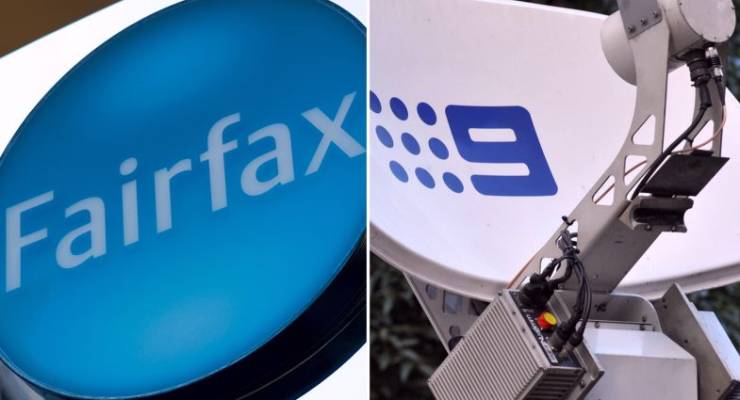
Last week, media giants Fairfax and Nine merged to form a new company, which is coincidentally, also called Nine. The effective end of a 177-year-old media company, the possible attendant job losses, the potential silencing of one more media voice, and the implications for regional media coverage are all occasions for worry. But how did we get here?
The media reforms that allowed this to happen have been pursued by the Coalition government for very a long time — specifically the removal of the “two out of three” rule, which prohibited a single company controlling a newspaper, TV network and radio network in the same area. Back in February 2016, Crikey politics editor Bernard Keane noted the troubled history of these reforms, and noted the long-term involvement of a Liberal stalwart:
Those with a good memory for such things will recall that “two out of three” was a last-minute addition to the 2006 media ownership package proposed by Peter Costello in order to get the Nationals onside (Barnaby Joyce voted against the laws, but Steve Fielding supported them, so they passed). Some say that Costello’s intervention was at the request of James Packer, who was keen to flog the Nine Network and who had close links with the then-treasurer and prime minister Howard. But that might just be scurrilous speculation.
Coincidentally, all these years later, Costello is the new chairman of Nine Entertainment.
But, as Keane put it later that year, the focus on the “two out of three” rule ignored a more complex reality:
But no matter where you come on two out of three, neither keeping it nor dumping it is going to protect diversity — or quality journalism — in the long term. That’s what has been missing so far from the limited debate around the current iteration of media reform — an understanding that any rule changes are only a holding measure in the full-scale retreat of traditional media before the forces of the internet. What does a long-term Australian media landscape look like? Traditionally the government, through its spending on public broadcasting and its high level of regulation of the media, has played a critical role in shaping that landscape — reflecting the social consensus that media is too influential simply to be left to the operation of the marketplace.
After months of wrangling across 2017, and what Senator Nick Xenophon called “the most difficult and protracted and robust set of negotiations I have engaged with in 20 years of being in parliament” the reforms passed.
Bernard Keane and Glenn Dyer surveyed who did well, and who didn’t, as well as a few stray observations about what might be next:
A potential purchaser of parts of Fairfax will now have greater flexibility to link those with other assets, potentially increasing its value, while its radio assets will enjoy the licence fee rort.
For Nine there’s also the licence fee rort, and the opportunity to link up other assets — it could bid for Fairfax, and merge with a regional television network. Regional broadcasters such as Prime Media Group also win — they’re waiting to be mopped up by someone such as Seven West media (which owns around 11% of Prime) and Southern Cross Austereo, which has ambitions of its own, but will probably be picked off …
Sounds good for everyone — but remember this: every round of media law changes in recent years has meant billions lost from exciting deals that turned out to be duds …
Would the laws have any affect on media diversity in Australia? It included a scheme for non-editorial financial assistance to regional and small Australian media companies (including Crikey). But, in the face of dire industry conditions, very little else:
The measures for small and regional publishers include a $60 million jobs and innovation fund, and subsidies for 200 journalism cadetships over two years, the majority of which will be for regional outlets. In exchange, Xenophon’s bloc of three senators voted for the government’s reforms that will clear the way for mergers between the big media companies — something they’ve been begging for.
But will Xenophon’s measures actually make a difference to the industry?
Since 2011, the Media, Entertainment and Arts Alliance (the journalists’ union) estimates 3000 journalist jobs in Australia have been cut, mostly through redundancy, but also through attrition. Just this year, Fairfax cut 125 jobs — including very senior and long-serving journalists — in a cost-saving measure. News Corp razed its picture and production desks this year, too. The ABC has also made more job cuts this year as a hangover from the 2014 budget cuts.
And if the merger worries you, it’s worth noting, as RMIT honorary fellow Vincent O’Donnell did in conversation with Crikey media reporter Emily Watkins, the media companies and those who run them might not be done yet:
O’Donnell says that if (or when) the two-out-of-three rule goes, the media could become incredibly concentrated, with only one or two people or companies controlling all the news and information in a community.
And once the media moguls have won their fight for these reforms to go through, O’Donnell thinks they’ll be emboldened for the next big regulatory push: local content rules.








Crikey is committed to hosting lively discussions. Help us keep the conversation useful, interesting and welcoming. We aim to publish comments quickly in the interest of promoting robust conversation, but we’re a small team and we deploy filters to protect against legal risk. Occasionally your comment may be held up while we review, but we’re working as fast as we can to keep the conversation rolling.
The Crikey comment section is members-only content. Please subscribe to leave a comment.
The Crikey comment section is members-only content. Please login to leave a comment.